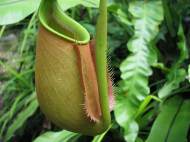Pitcher plant biomimicry leads to SLIPS – efficient liquid repelling coating
 Inspired by pitcher plant, a group of applied scientists at Harvard University managed to create a material that repels just about any type of liquid, including blood and oil, and does so even while it is exposed to high pressure or freezing temperatures. Since it is carnivorous by nature, the ability to have a virtually frictionless surface inside its cupped leaf is crucial for its ability to capture insects or small frogs.
Inspired by pitcher plant, a group of applied scientists at Harvard University managed to create a material that repels just about any type of liquid, including blood and oil, and does so even while it is exposed to high pressure or freezing temperatures. Since it is carnivorous by nature, the ability to have a virtually frictionless surface inside its cupped leaf is crucial for its ability to capture insects or small frogs.
We already wrote several articles about hydrophobic (water repellent) surfaces which biomimic the lotus leaves, however, this approach doesn’t perform well with organic or complex liquids. It also loses its ability once it is scratched or exposed to extreme conditions.
“Inspired by the pitcher plant, we developed a new coating that outperforms its natural and synthetic counterparts and provides a simple and versatile solution for liquid and solid repellency”, said lead researcher Joanna Aizenberg, Amy Smith Berylson Professor of Materials Science at the Harvard School of Engineering and Applied Sciences (SEAS).
Instead using air-filled nanostructures to repel water, the pitcher plant locks in a layer of water and uses it as a slick coating. Inspired by this ability, Harvard scientists designed a method to create slippery surfaces by infusing a nano/microstructured porous material with a lubricating fluid. The method is used to create Slippery Liquid-Infused Porous Surfaces (SLIPS) which are capable to repel a wide variety of liquids and solids.
“The repellent fluid surface offers additional benefits, as it is intrinsically smooth and free of defects”, said Tak-Sing Wong, a postdoctoral fellow in the Aizenberg lab. “Even after we damage a sample by scraping it with a knife or blade, the surface repairs itself almost instantaneously and the repellent qualities remain, making SLIPS self-healing.”
The researchers have demonstrated that the near frictionless effect persists under extreme conditions such as high pressure (as much as 675 atmospheres), humidity, and low temperatures. They conducted tests outside after a snowstorm where SLIPS withstood the freezing temperatures and even repelled ice.
“Not only is our bio-inspired surface able to work in a variety of conditions, but it is also simple and cheap to manufacture”, said Sung Hoon Kang, a Ph.D. candidate in the Aizenberg lab. “It is easily scalable because you can choose just about any porous material and a variety of liquids.”
SLIPS can be made optically transparent which makes them suitable for self-cleaning surfaces in optical applications. The bio-inspired liquid repellence technology could find applications in biomedical fluid handling, fuel transport, and anti-fouling technologies. Other potential applications include surfaces that resist bacteria, ice-resistant materials or even new anti-sticking surfaces that repel fingerprints or graffiti.
For more information, read the article published in the journal Nature named: “Bioinspired self-repairing slippery surfaces with pressure-stable omniphobicity”.










Excellent case of biomimicry.
Dr.A.Jagadeesh Nellore(AP),India
E-mail: anumakonda.jagadeesh@gmail.com